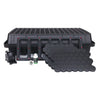
Cloning Systems
, by Adam Marosi, 3 min reading time

, by Adam Marosi, 3 min reading time
When considering your setup for your vegetation and flower room, one of your considerations should be for a cloning machine. A plant cloning machine makes the process of cloning your plants easier and efficiently. In this posting we will talk about cloning systems, how they work, how to clone and some advantages and disadvantages.
When considering your setup for your vegetation and flower room, one of your considerations should be for a cloning machine. A plant cloning machine makes the process of cloning your plants easier and efficiently. In this posting we will talk about cloning systems, how they work, how to clone and some advantages and disadvantages.
Cloning systems are plastic squares or circular holes that are filled with soft or hard neoprene inserts. Those are the cloning sites. The amount of neoprene inserts will depend on the machine and your needs as a gardener. The smallest size cloning system you can get is a 4-collar. The largest size cloning system you can get is 180-collar.
Taking a clone from a plant is a very simple and easy process. What you’ll need for this process is pruning scissors, razor, glass of water or glass of water mixed with a rooting solution, T-5 or CFL grow light and a cloning machine. Before you start cloning you will need to set-up your cloning machine (see assembly instructions) and add nutrients to the reservoir, clean and disinfect your scissors and razor, set-up your grow light, make your glass of water to hold the clones and finally have a clean and disinfected area to clean your clones. Once that is ready to go you can start cloning.
First the grower will need to look at the plant for new growth. The new growth is where you will be taking your clones from. You can always take clones from anywhere on the plant. Whenever possible take the clones from the lower half of your plant. Those clones will have more rooting hormones than the top half. Once you’ve found the new growth and the branch to cut you can take a clone. When taking a clone, the grower should have three things in mind. One being the clone should be about 5-8 inches in length. Second you need to cut it at a 45-degree angle. Finally, the clone should be taken from above a node. After cutting the clone, place it into the glass of water immediately. This will prevent air bubbles from getting into the stem. Next you should cut off any huge leaves and just leave a couple some smaller leaves on. This will prevent the clone from over exerting itself trying to turn light into food. After the grower takes the clone out of the water you will need to place it on your clean and disinfected area. Where the 45-degree angle cut is you will need to take your razor and cut a 90-degree angle going up the stem about a half-inch up. This will open the bottom of the stem leaving more surface area for roots to grow out of and promotes faster rooting. Next, the grower will take a cutting of your plants and place them into the neoprene cloning sites and turn on the water pump. The pump will then force the nutrient mixture through the spray nozzles, covering your cuttings in a highly-oxygenated mist filled with nutrients. Finally turn on your grow light. The grow light for the first 4-6 days won’t need to be at full strength or close to the clone. The clone is getting used to the new environment and using the lighting for developing roots. After the 7 day mark you can place your light closer to the clones for new growth. The grower should have a fully rooted clone in about 10-14 days.
Advantages:
Disadvantage:
